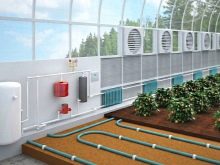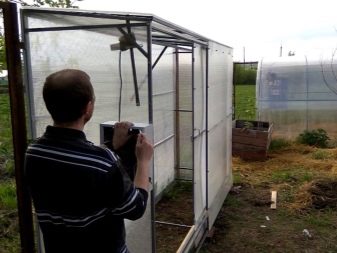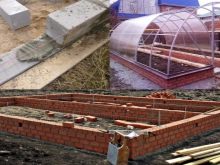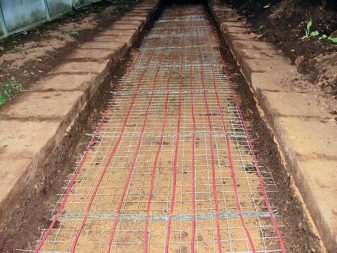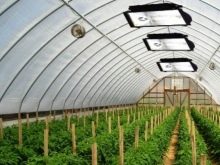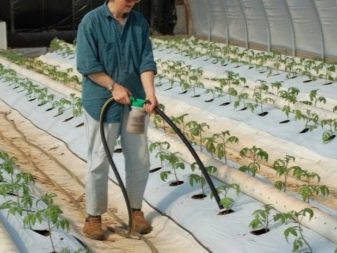"Smart" greenhouse: design features and stages of automation
"Smart" greenhouses are not too common, so many believe that the average gardener can not build something like that in his yard. But in reality this is not at all the case.
The advantages of automation
The benefits of smart greenhouses are obvious. This is not just a place where plants are protected from frost and can bear fruit all year round. "Smart greenhouse" - this is a real assistant gardener. Due to the fact that routine processes are automated, a person does not need to spend his time on everyday tasks.
Of course, even “smart” greenhouses are not able to grow plants without human intervention. But they can do a lot.
Here is a list of the main functions of such buildings:
- Maintain a comfortable temperature inside. The ventilation mode is automatically turned on in the room, so on hot days, vegetables, fruits and berries will not wilt under such conditions.
- Water the plants at the set time.The drip irrigation system is automated and extremely easy to manage. Even a novice summer resident can easily cope with its configuration.
- To restore the soil and make it suitable for growing a selected plant variety.
It turns out that some simple routine duties can really be entrusted to the system. But staving, transplanting and other complex processes remain the task of the gardener. But to cope with them is much easier.
Kinds
Despite the fact that such designs at first glance seem very complicated, it is quite realistic to reproduce them. First you need to decide on what type of greenhouse will be selected. Conventionally, they are divided into two categories: autonomous and volatile.
The first option is very profitable and modern. Autonomous greenhouse, as the name implies, does not depend on the mains. As a rule, it works on solar or heat energy. Both options are good, but you will have to spend a lot of time on the equipment of such a greenhouse.
The second option is simpler. Volatile system operates from the mains. And here there are two minuses at once. Firstly, a lot of electricity is spent, so you have to pay a lot for utilities.In addition, if the light suddenly turns off, then such a “smart” greenhouse immediately turns into a normal one. But such an automatic design is cheaper autonomous.
In addition, greenhouses, both modern without electricity, and traditional, working from the mains, differ in their size. Here you need to look at the circumstances: the larger the plans and the more free space, the greater the greenhouse you can afford. A more compact option is a simple greenhouse with an opening lid. It can also be supplemented with various technical innovations.
Functions
Each gardener determines for himself which functions of the “smart” greenhouse are important to him. Here are the main ones:
- Ventilation. To maintain the desired temperature in the greenhouse, you need to equip the room with windows that open automatically. The opening of the window occurs either at a certain period, or after the temperature rises. Adjusting the temperature and maintaining it allows you to grow healthy plants and get a rich harvest.
- Automated watering system. A good "smart" greenhouse must be equipped not only with an air temperature sensor, but also with an automatic watering system.Drip irrigation of plants allows you to solve the problem of regular watering.
- Soil recovery. Soil mulching in automatic mode is another useful feature for which many “smart” greenhouses are famous. This allows gardeners to forget about replacing the soil, even if a person grows plants all year round, while planting different crops.
This, of course, not all. Many greenhouses are literally crammed with various systems. But for starters, a simple climate control system is enough.
How to do?
Since the finished greenhouses are expensive, many gardeners prefer to do everything with their own hands. Here is a simple instruction that allows you to cope with this task in a short time.
Choosing an installation site
First you need to decide on where the "smart" greenhouse will be installed. Under it you need to take a large enough part of the site.
Another important point - the greenhouse should be protected from strong gusts of wind. This is especially true if the design itself is not very durable. So it is best to have a greenhouse in a place protected from the wind. Additionally, you can put a fence.
In this case, through the windows of the greenhouse, the rays of the sun must fall into it in order for the plants to grow normally. Otherwise, they will need additional lighting, the support of which will leave a lot of money.
After a suitable place is chosen, it is necessary to consider also such an important point as the choice of the ideal material for the construction of the greenhouse. To make plants comfortable even in the cold season, the walls should be made warm. After all, if they are thin, then no heating system will help to maintain the desired temperature - all the heat will go outside. The best material option is polycarbonate. Walls up to 8 millimeters thick are suitable for the construction of greenhouses used from spring to early autumn. If, however, vegetables, fruits and berries will grow there and in the winter, then it is worth stopping at the walls with a thickness of 16 millimeters.
Additionally, you need to very carefully seal the joints. You should not save on doors and double-glazed windows - windows and doors should close very tightly.
Another way to keep the heat indoors all year round is to use a heat insulating foundation. Due to this, the roots of all plants will always be warm, which means that they will grow very quickly.
Do-it-yourself automation
The next important point is design automation.If it is completely self-made, then at this stage there will be the most difficulties. First you need to choose the right equipment for the price. There are different options and schemes that will suit gardeners with a different budget.
First of all, all necessary sensors are installed. The best option for the price - the sensors in the module version of the Arduino. They are sold together with the scheme and clear instructions. The standard set, as a rule, includes a shutter with a thermal sensor, electrical circuits, a photoresistor and a soil moisture sensor.
At the same stage, you need to take care of heating the room. There are two options. The first - electrical heating. The scheme includes the connection of underfloor heating, infrared devices and convectors. Another option is to connect water heating. The center of the circuit here is a boiler of any type. Unfortunately, in terms of safety, it is impossible to automate the operation of heating devices in any way, so you will have to manually control the operation of boilers.
If you want the system to be fully automatic, it is better to choose electric heating.
For heating the air is to choose electric heaters. They are recommended to have higher.The best option is to attach them to the greenhouse frame along with sensors and electrical circuits. With this arrangement, the sensors automatically measure the air temperature, and if it is below the required level, they start heating it.
As a rule, in a “smart” greenhouse it is enough to install an automatic lift on the windows. But if you want, you can also install a system of forced ventilation. In this case, the electric fans are also attached to the arcs of the greenhouse frame. They are connected to the mains and transferred to automatic mode. The system works very simply: as soon as the sun heats the roof of the greenhouse too much, the fans automatically turn on. But you can do without fans - to add windows with a drive with automatic. When the temperature rises, they will open and then close just as easily. And all this without the intervention of the gardener.
In order for the soil to always be suitable for growing plants, experienced gardeners use mulch. This is loose organic matter that does not allow the earth to dry out. It turns out that the soil is constantly loose and well heated.Mulching, among other things, also saves plants from weeds. This is true at any time of the year. True, in the spring and autumn, experts recommend additionally covering the mulch with dark polyethylene. Due to this, the soil warms up even better and the plants begin to develop much more actively.
For the summer, this dense material, of course, is removed. But the soil is still not recommended to leave uncoated. Thick film can be replaced with either straw or fresh sawdust. Both that, and other material allows to evenly distribute heat on all greenhouse.
Additional improvement
In addition to these highlights, there are a number of additional improvements that will make the smart greenhouse better and more functional.
First, you can pay attention to such a function as heating the soil. This can be done in three ways. The first is natural. But this is a way that is suitable only for summer, because the soil is heated by the direct rays of the sun. The second option is biological. Material is buried in the soil, which gradually decomposes and releases heat. Due to this, the earth is constantly well warmed up.But there is also a minus - it is impossible to regulate the temperature.
The most interesting way for connoisseurs of modern technology is technical. Underground pipes are laid, which give heat. This is convenient, because at any time you can set the desired temperature or turn off the heating system altogether.
You can increase the amount of the crop by installing lamps in the room. The backlight is especially important in the cold season - from late autumn to early spring. Any kind of lamp will do, because each has its own advantages. For example, sodium give light, like solar. Luminescent are economical, and the LED is as safe as possible, so the greenhouse, supplemented with such lamps, can be safely left unattended for a week or two. By the way, the lighting, too, should ideally be automatic. The light should turn on in the dark and fade away with the onset of the day.
Useful tips
Finally, here are some more interesting recommendations from those who have already equipped the “smart” greenhouse on their site.
First, in order for the harvest to always be excellent, you need to take care of the selection of high-quality fertilizers.Another interesting way to increase yield is to use Californian worms. They loosen the soil and actively restore the upper layers of the soil. If you add these helpers to your greenhouse, you can forget about the problem with a lack of fertilizers.
The second important tip is that the temperature inside the greenhouse should never be much higher than the outside. Of course, greenhouses are always built so that you can grow plants in more comfortable conditions and get more yield. But large temperature drops can harm both seedlings and already full-fledged plants. In addition, under such conditions, pathogenic microorganisms can develop more actively, which is also very bad for the crop.
If we talk about the ventilation of the room, it is worth clarifying that the windows that automatically open are best placed on the roof. This is done because on hot days the heat goes up. And if there is a window leaf at the top, it will be easier to ventilate the room.
There is another important point - the design must necessarily be sealed. Many people forget about it, and streams of warm air constantly leave the room.But simply enough to correctly calculate the ventilation and make the room airtight.
It is also impossible that the greenhouse stood in the sun. Too intense sunlight will damage the plants. To prevent this from happening, you can put a hedge near the greenhouse. It is both functional and beautiful. It is also possible to use attached materials, hiding the necessary part of the greenhouse and hiding there those plants that love shade.
A “smart” greenhouse is a great option for both busy summer residents and those who just want to grow more plants per season. Such designs are perfect for those gardeners who do not have the opportunity to go there regularly: it is enough just to automate all the basic processes, and the plants will develop and bear fruit without the participation of the owners, literally on the machine.
To learn how to automate the cultivation of vegetables in a smart greenhouse, see the following video.


